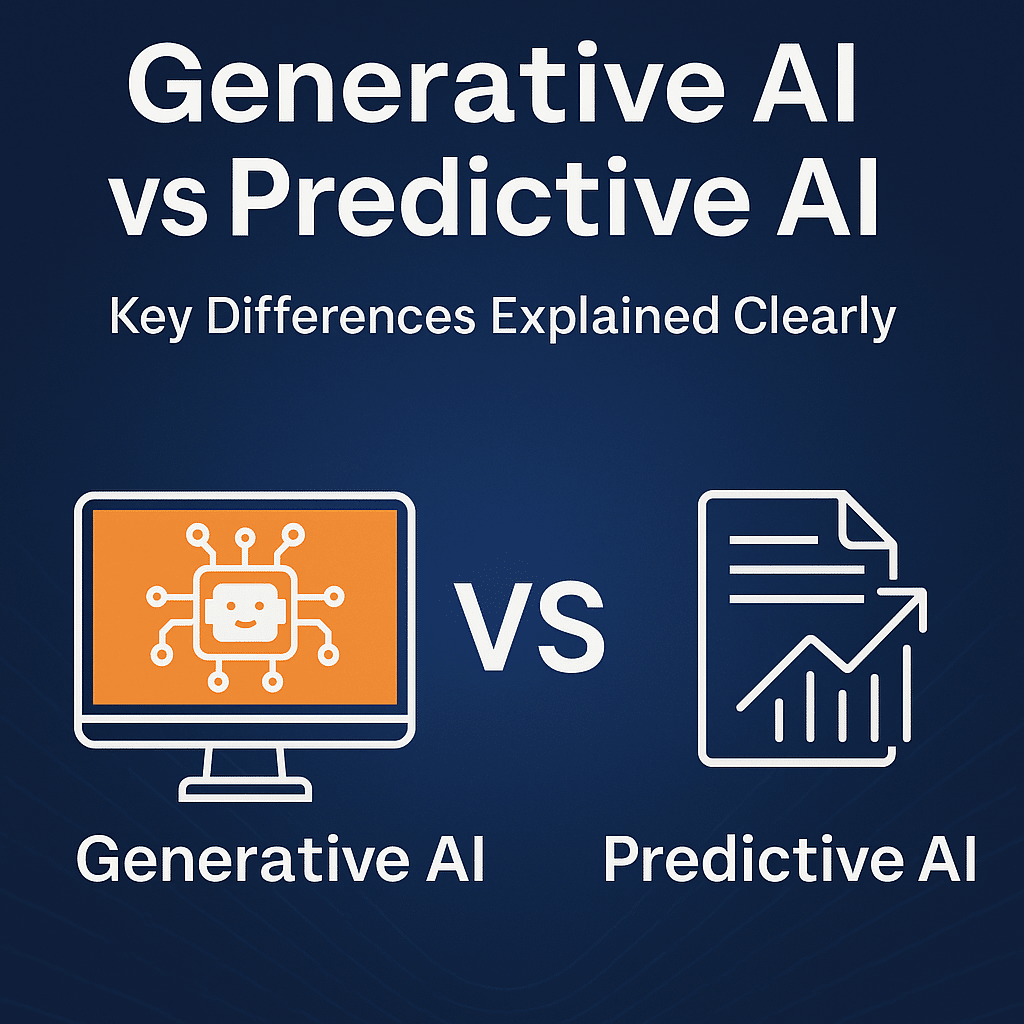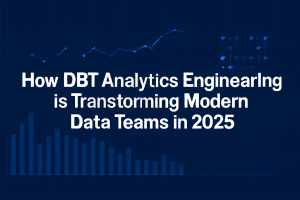TL;DR
- Generative AI creates, Predictive AI forecasts – two sides of modern AI systems.
- Generative AI handles text, visuals, and conversations through deep learning and large language models.
- Predictive AI relies on historical data and machine learning to predict future outcomes.
- Used together, they merge creativity with foresight – powering AI applications from chatbots to supply chain management.
- For business leaders, understanding both is essential to building a smart, responsible AI future.
Introduction – Two AI Types Changing Everything
Artificial intelligence (AI) now powers everything, from digital art to predictive analytics that guide billion-dollar decisions. Among its many branches, two AI types dominate the 2025–2026 innovation race: Generative AI and Predictive AI.
They’re built on similar machine learning foundations, yet their goals couldn’t be more distinct. Generative AI creates new content, words, code, or visuals, while Predictive AI forecasts what’s likely to happen next. Together, they form the core of today’s AI technologies shaping smarter automation, personalized customer engagement, and real-time insights.
From virtual assistants that speak like humans to tools that anticipate customer behavior, understanding both is no longer optional; it’s essential for every data-driven professional.
Understanding the Two AI Types
What Generative AI Does
Generative AI focuses on creation. It learns from training data and then generates something entirely new, such as text, realistic images, software code, or even synthetic data for testing AI systems.
At its heart lie deep learning techniques and large language models that process vast amounts of natural language. When fine-tuned, generative AI models can write, design, or compose content with a human-like tone and logic.
Some common AI applications include:
- Content creation for blogs, video scripts, and product descriptions
- Software development automation through code generation
- Conversational AI chatbots that answer in context
- Virtual assistants that manage schedules and interactions
Generative AI promises speed, creativity, and automation. It excels at reducing repetitive tasks and opening new possibilities for innovation across industries.
What Predictive AI Focuses On
Predictive AI, in contrast, is about anticipation. It studies historical data using machine learning models and statistical analysis to detect patterns and predict future outcomes.
This type of AI doesn’t create new material, it forecasts the future by interpreting existing data.
Typical predictive AI models support:
- Fraud detection in banking and finance
- Supply chain optimization and logistics planning
- Customer behavior prediction to improve customer engagement
- Medical images analysis for early disease detection
By combining neural networks with statistical algorithms, predictive AI forecasts future trends, enabling better decision-making and measurable business value.
| Aspect | Generative AI | Predictive AI |
| Purpose | Produces new, unique content | Forecasts future events or outcomes |
| Input Data | Uses training data to learn patterns and generate new content | Uses historical data to analyze and predict trends |
| Output | Text, images, code, audio | Probabilities, scores, or forecasts |
| Tech Core | Deep learning & large language models | Statistical algorithms & machine learning models |
| Applications | Chatbots, content creation, virtual assistants | Risk prediction, demand forecasting, customer insights |
Generative AI vs Predictive AI – The Core Differences
Distinct Capabilities and Goals
Both AI models rely on learning from data, yet their desired output differs dramatically. The table below illustrates the key differences in structure, goals, and outcomes.
While generative AI sparks creativity, predictive AI anchors decision-making. In business terms, one builds experiences, the other predicts outcomes that drive growth.
How Generative and Predictive AI Work Together
Though different, they’re not rivals, they’re complements.
Organizations increasingly integrate generative and predictive AI in unified AI systems to enhance automation and intelligence.
For instance:
- A predictive AI engine may anticipate customer behavior based on historical data.
- The generative AI layer then crafts personalized marketing content to improve customer engagement.
This synergy lets business leaders deploy adaptive AI tools that learn, create, and react simultaneously, turning raw data into meaningful, human-like communication.
Inside the Technology
Training Data and Model Design
Every AI model thrives on quality data. For predictive AI, large volumes of clean, historical data are essential to recognize correlations and forecast trends. Generative AI, on the other hand, requires diverse training data that reflects language, code, or imagery patterns to generate realistic outputs.
High-quality data ensures these systems perform ethically and consistently, a pillar of responsible AI. Weak or biased data can create flawed predictions or misleading content, so most AI technologies now embed continuous data evaluation.
Example: In healthcare, predictive AI models can estimate disease likelihoods from patient histories, while gen AI models produce simulated medical images for safer model testing.
Neural Networks and Machine Learning Models
Both AI types rely heavily on neural networks, layered algorithms that mimic the brain’s learning patterns. In predictive AI, networks recognize relationships in existing data to generate accurate forecasts.
Generative AI models push this further, they use machine learning combined with deep learning to understand context and craft new outputs. Each generation loop improves performance, creating smarter, more adaptive systems.
This constant feedback between training data and model refinement forms the backbone of modern AI solutions powering real-world automation.
Applications Across Industries
Generative AI Use Cases
Generative AI has reshaped creativity and automation in nearly every field. Its ability to produce high-quality, original outputs from minimal prompts has made it one of the fastest-growing AI technologies.
Here’s where it shines:
- Content creation: Generates articles, ads, or visuals that match brand tone and context.
- Software development: Assists software developers by writing or optimizing computer code.
- Conversational AI: Powers virtual assistants and chatbots that understand natural language.
- Synthetic data: Produces realistic but artificial datasets for safe AI training or testing.
By handling repetitive tasks at scale, generative AI tools enable professionals to focus on strategy and creativity instead of routine work. It transforms raw training data into innovative material, helping organizations experiment faster and more affordably.
Predictive AI Use Cases
Predictive AI has quietly become the decision engine behind the world’s most advanced AI systems. It doesn’t generate – it anticipates. Using machine learning models, it learns from historical data and forecasts future outcomes with impressive accuracy.
Common use cases include:
- Fraud detection: Identifies suspicious transactions before damage occurs.
- Supply chain management: Optimizes logistics through predict future outcomes analysis.
- Customer behavior: Predicts buying patterns to design smarter marketing campaigns.
- Healthcare: Detects anomalies in medical images to alert clinicians early.
These predictive AI forecasts help businesses plan better, prevent risks, and generate measurable business value. Combined with generative AI, they create end-to-end AI solutions that act, learn, and communicate intelligently.
Few Examples of Combined AI Applications
The most exciting breakthroughs occur when generative and predictive AI work together:
- Personalized marketing: Predictive AI anticipates which users might engage, while generative AI crafts targeted messages.
- Software testing: Predictive models detect bugs, and gen AI models rewrite cleaner software code.
- Healthcare diagnostics: Predictive systems evaluate risk scores, and generative AI generates synthetic patient data for safe experimentation.
Together, they transform static data into dynamic insight – merging analysis and creativity to drive continuous improvement.
Why These AI Technologies Matter
Business Leaders and AI Strategy
For modern business leaders, understanding generative AI vs predictive AI is crucial to designing a forward-looking AI strategy. Both fuel growth but in very different ways:
- Predictive AI turns data into foresight.
- Generative AI turns data into output.
Used responsibly, these AI models redefine operations, enhance decision-making, and support responsible AI standards. A well-balanced approach allows companies to forecast future outcomes and generate tailored experiences simultaneously.
Executives now view these models not as tools but as strategic co-pilots – helping automate judgment, creativity, and customer connection all at once.
Deeper Insights and Future Trends
Future trends in AI technologies point toward tighter integration. Businesses will increasingly merge generative AI’s creativity with predictive AI’s precision for systems that both understand and act.
Expect advances in:
- Natural language processing for more contextual conversations.
- Big data integration for sharper forecasting.
- Ethical oversight ensuring responsible AI deployments.
- Cross-functional AI applications bridging finance, retail, and medicine.
As organizations collect more high-quality data, both AI types will become smarter, safer, and faster – a true partnership between prediction and imagination.
Final Thoughts – Choosing the Right AI Type
Selecting between generative AI and predictive AI depends entirely on your desired output and purpose.
- Choose Predictive AI when your goal is to predict outcomes, minimize uncertainty, and make data-backed decisions.
- Choose Generative AI when your focus is creation, innovation, and content generation.
- Combine both when your business needs creativity backed by intelligent forecasting.
Ultimately, these distinct capabilities fuel the same mission: helping AI systems evolve from reactive to proactive, and from functional to intelligent. Whether you’re building smarter chatbots, refining supply chain optimization, or developing AI applications that redefine engagement – mastering both forms of artificial intelligence is key to staying ahead in the next era of innovation.
If you’re interested in deepening your understanding of ethical frameworks and compliance in artificial intelligence, check out our detailed guide on Top AI Governance Certifications To Earn In 2026.
Frequently Asked Questions (FAQs)
1. What is the difference between Generative AI and Predictive AI?
Generative AI creates new content using patterns learned from data, while Predictive AI analyzes existing data to forecast future trends or outcomes.
2. Can both Generative and Predictive AI be used together?
Yes. Many AI systems now combine both – predictive AI provides insights, while generative AI builds outputs or responses from those predictions.
3. How does Predictive AI improve business performance?
It helps organizations anticipate customer behavior, optimize operations, and reduce risk through accurate predictive AI forecasts.
4. What are examples of Generative AI applications?
They include content creation, virtual assistants, software development, and synthetic data generation for testing models safely.
5. Why are Neural Networks important in AI?
They enable machine learning models to process complex information, recognize patterns, and generate or forecast data accurately.
6. Which AI type offers more business value?
Both. Predictive AI drives smarter decisions; Generative AI delivers innovation. Together, they maximize AI solutions and strategic advantage.
7. Is Generative AI responsible for Conversational AI?
Yes. Generative AI powers many conversational AI tools and virtual assistants that generate responses in natural language.
8. What skills are needed to work with these AI models?
Understanding machine learning, data handling, and responsible AI principles is key. Familiarity with neural networks and training data improves model accuracy.
9. How will these AI technologies evolve by 2026?
Expect more synergy – systems that generate, predict, and self-optimize using big data, deep learning, and ethical AI frameworks.



























